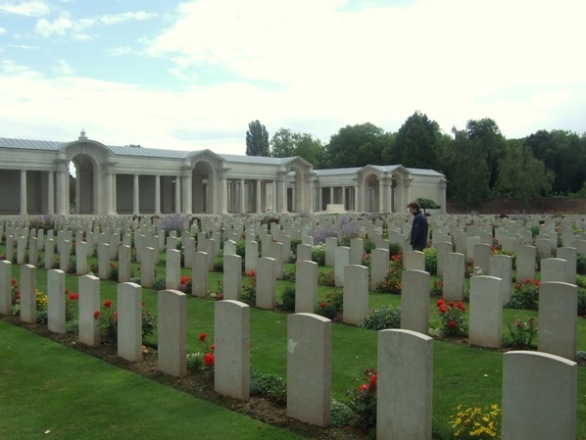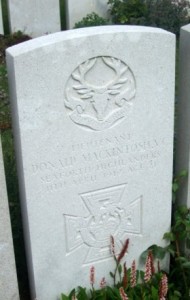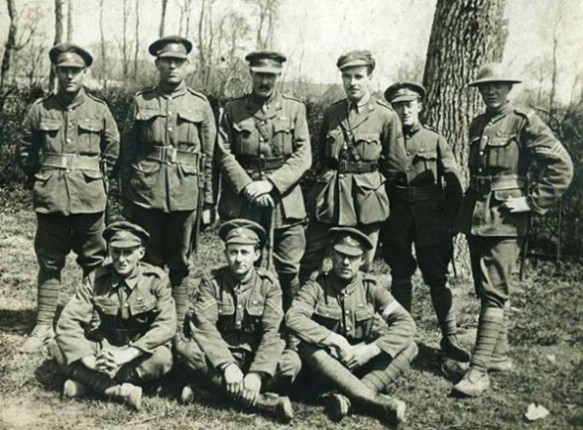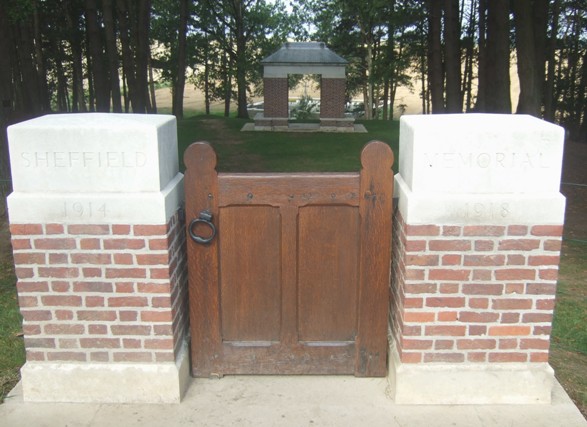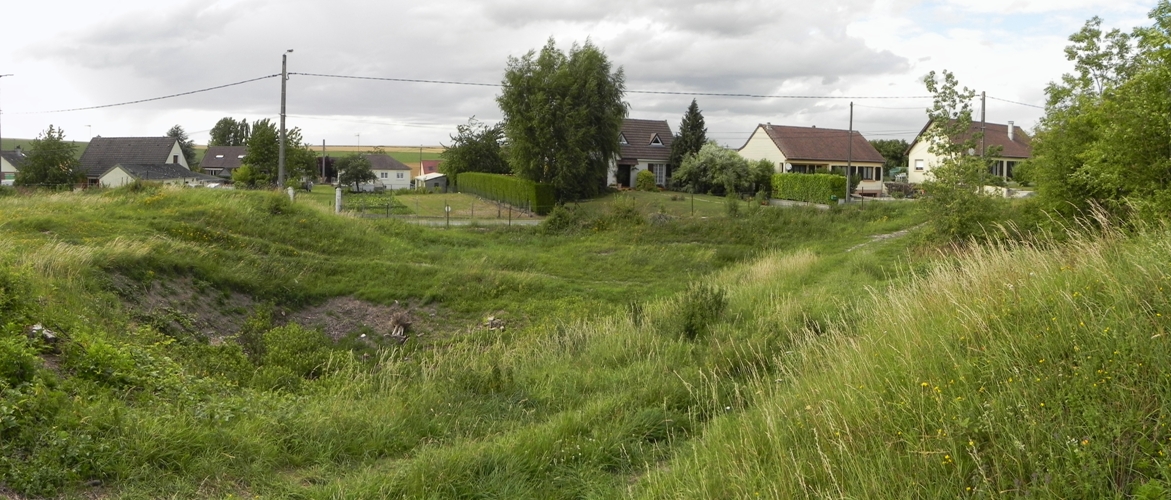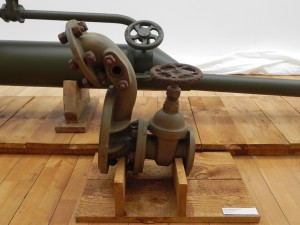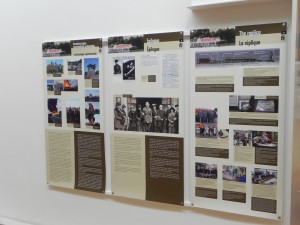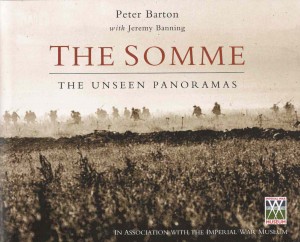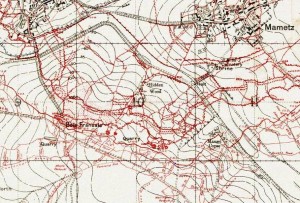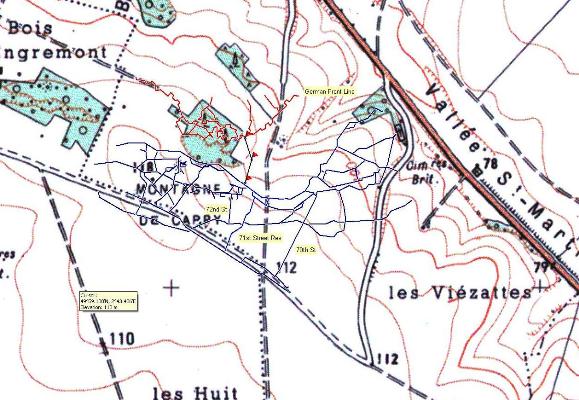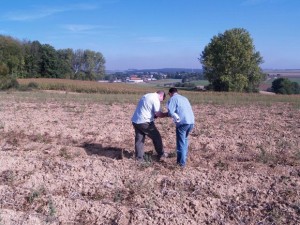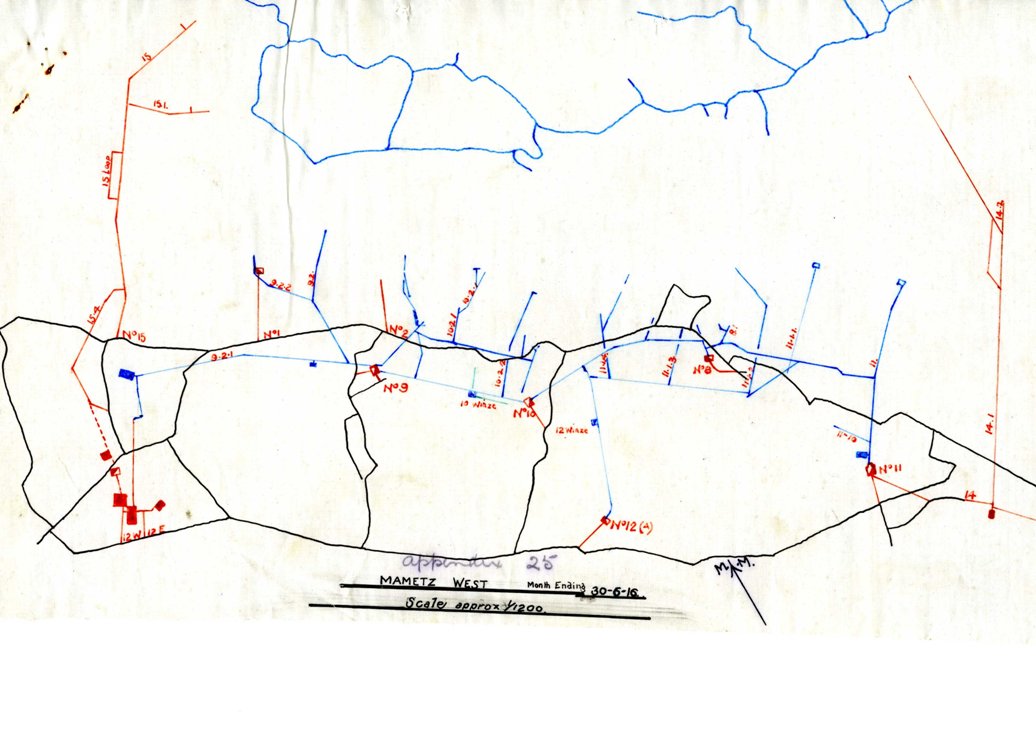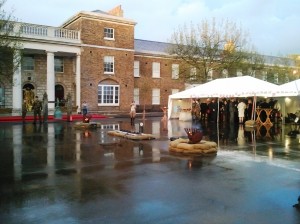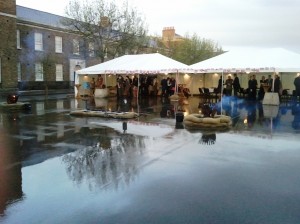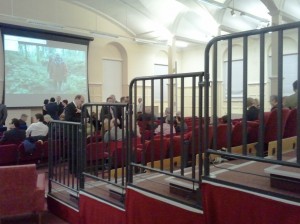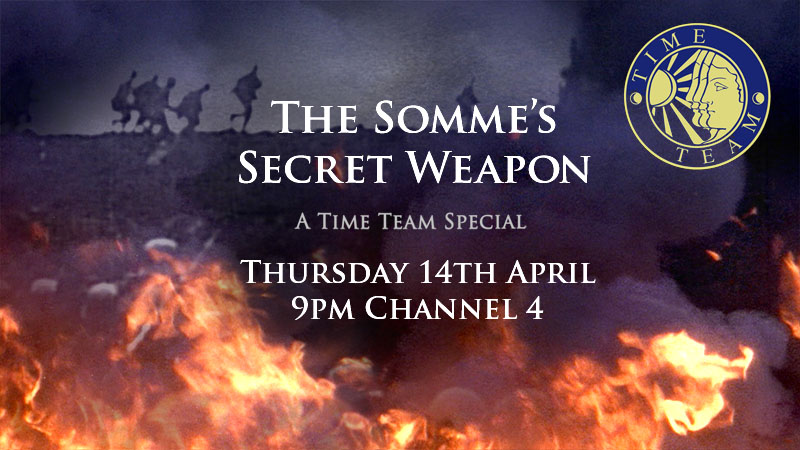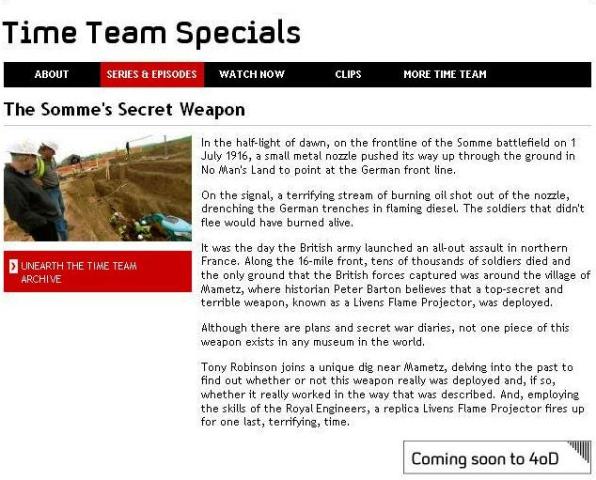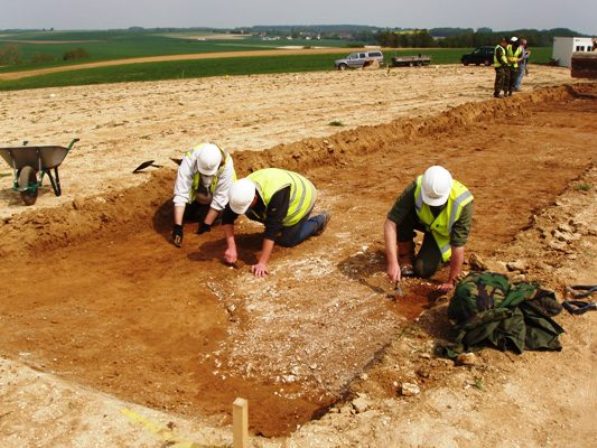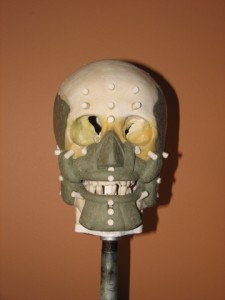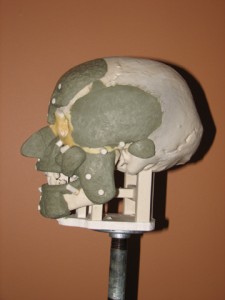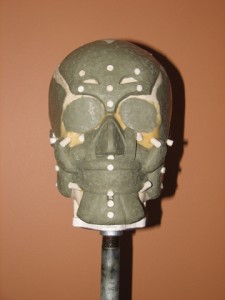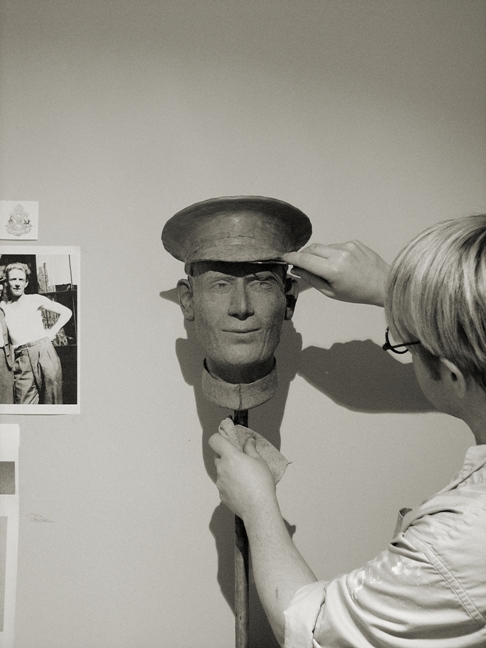Posts Tagged ‘Great War’
A whistlestop battlefield trip – Arras & the Somme in two days
Last week I spent an enjoyable two days on the battlefields with four clients. For all but one of them it was their first visit to the western front. We met bright and early on Monday morning at the Channel Tunnel terminal and travelled over in convoy down to Arras.
Arras
Our first stop was in the superb Carriere Wellington. Our guide, the irrepressible Pascal, was as keen as ever and coupled with my preliminary talk on the Battle of Arras and the ten minute ‘taster’ film shown prior to going underground my group got a good initial grasp of the battle in April & May 1917. Following our hour underground we visited the Arras Memorial to the Missing and Faubourg d’Amiens Cemetery. The sheer scale of men with no known grave from the Arras battlefields had the usual sobering effect.
Being so close we popped into the Mur des Fusillés and paid our respects at the site where 218 French resistance and civilians were shot by the Germans in the Second World War. I have always found it an eerie place with a strange atmosphere all of its own.
We then headed out to the Great War battlefields around Arras with the first stop the Point du Jour for a visit to the military cemetery and the graves of the 10th Lincolns men (Grimsby Chums) found in 2001 and the impressive 9th (Scottish) Division memorial re-sited next to the cemetery. After a picnic lunch in the cemetery we headed back into Athies and along to Fampoux. The village marked the point of furthest advance into German lines on 9 April 1917. We stopped at the sunken lane to look at the attack of the 2nd Seaforth Highlanders and 1st Royal Irish Fusiliers (10th Brigade, 4th Division) against Greenland Hill and Roeux on 11 April 1917. Whilst at the Sunken Lane Cemetery overlooking the sloping fields down to Roeux I told my group of Donald MacKintosh and the actions that earned his Victoria Cross. We then drive through Roeux past the site of the Chemical Works (now a Carrefour mini-supermarket) and around to Brown’s Copse Cemetery to pay our respects at MacKintosh’s grave.
Back on the road we crossed the Scarpe and headed up to Monchy-le-Preux. I pointed out the positions of various trench lines and explained about the catastrophic failure of the 3 May attack, the Third Battle of the Scarpe. We then had a drive around Monchy, stopping at the stunning 37th Division memorial and the Newfoundland Caribou Memorial which is built on the top of a British artillery observation post constructed in August 1917 by 69 Field Company RE. Our day’s battlefielding was completed with a stop east of the village on Infantry Hill where I told of the disastrous 14 April attack by 1st Essex Regiment and the aforementioned Newfoundlanders. Both battalions were destroyed in carefully planned German counter-attacks – the first use of the new doctrine of ‘elastic’ defence. Monchy was at the mercy of the Germans and the situation was only saved by the quick thinking action of Lt-Colonel James Forbes-Robertson and a small group of men – all decorated for this action and known thereafter as the Heroes of Monchy.
We had a pleasant walk up Infantry Hill to the Mound and then headed back into Arras to pick up my car and then headed down to the Somme for a welcome meal and good night’s sleep.

The view of Infantry Hill from Green Lane. Bois du Vert sits on the horizon to the right of the picture.
The Somme
The next day was spent touring the 1916 Somme battlefield. Very much aware that one can only skim over the surface with one day around such a large and important battlefield we were up early to make full use of the daylight. After an explanation in the car park on the battle using various maps we set off north up to Serre, the most northerly point of continuous attack on 1 July 1916. En route we pulled the car in at the Ulster Tower for a view across the Ancre and an explanation of events in the northern part of the battlefield. The Gospel Copses at Serre were deserted and we had Sheffield Memorial Park all to ourselves as I explained about the failure of the attack and the losses incurred by the northern Pals battalions of the 31st Division.
After some time in Railway Hollow Cemetery we stopped at Serre Road Cemetery No.2 (the largest on the Somme battlefield) and the across the Redan Ridge to Beaumont Hamel, and the infamous sunken lane, the jumping off point for the 1st Lancashire Fusiliers that fateful morning. We then retraced our steps and stopped for a pleasantly quiet walk around the preserved trenches of Newfoundland Memorial Park with its Caribou and even more imposing memorial to the 51st (Highland) Division, conquerors of Beaumont Hamel in November 1916. Our next stop was to the magnificent Thiepval Memorial to the Missing, a must for any battlefield visitor to the western front. Heading via Pozières of Australian fame we reached the Old Blighty Tea Rooms at La Boisselle for a deserved late lunch.
The afternoon began with a detailed tour around the Glory Hole at La Boisselle and a good walk around the site looking at the craters and depressions marking the trenches followed by a stop at the unmissable Lochnagar Crater.
We then headed east through the battlefield, past Contalmaison, Longueval and Guillemont to the Cedric Dickens cross at Ginchy overlooking Leuze and Bouleaux Woods. This was a special stop for one of the group whose grandfather had served with the 1/8th Middlesex Regiment and who had probably been in these very fields in mid-September 1916.

Jack & John with Bouleaux Wood in the background. John’s grandfather served here in September 1916 with the 1/8th Middlesex Regiment.
Our final stop of the day was to the site above Mametz of our successful archaeological dig for a Livens Large Gallery Flame Projector where I could stand my clients on the spot where the parts had been recovered in May 2010. Sadly we did not have time to all visit the Historial de la Grande Guerre at Peronne to see the temporary exhibition and salvaged projector parts as well as the full size replica but there is only so much we could do within the time constraints.
“I would just like to say a big thank you for making our battlefield tour such an interesting and amazing event. Your knowledge of the area and what went on and where, is just incredible. The tour was made that much better by the fact that you had researched my Grandfather’s service in the Middlesex Regiment and proceeded to show us exactly where he was and what he would have experienced almost to the day but 95 years ago. It made the hair stand up on the back of my neck!
The choice of locations that you picked were excellent, and whilst I know two days is not long enough to cover everything there is to see, we certainly got a very good understanding of what happened, by whom and where. This was made even more poignant by linking them to my ancestors who had fought there. I would have no hesitation in recommending your tours to any of my friends, in fact I have told them of my experience with you and we are already planning another tour for next year.” John Waterman, Kent
It was a terrific trip with delightful people who have clearly got the battlefielding bug. My thanks to John, Clare, Sally and Jack for their enthusiasm, understanding and for sending me a selection of photos. I am already looking forward to the next time…
I was contacted by the Canadian Portrait Academy (CPA) when I first wrote a blog entry on the positive identification of Thomas Lawless. I initially saw news of this via my Twitter feed and realised what a good news story it was. I like to keep tabs on ‘news from the front’ and knew that this story fitted the bill perfectly. Little did I know the interest it would generate. Since that first post I have been heartened by the enthusiasm and generosity of those involved in the process to share their time and material so willingly.
The CPA have been wonderful in keeping me up to date with events and, through them, I have made contact with Christian Corbet, the sculptor who worked as the Forensic Artist with the Department of National Defence and others to reconstruct a likeness of Thomas Lawless.
Mr Corbet has kindly agreed to let me post images of his work on the facial reconstruction process. These photos are copyright and reproduced by kind permission of Christian Corbet. They show a few of the stages in the reconstruction process and are clear evidence of the levels of technical quality employed.
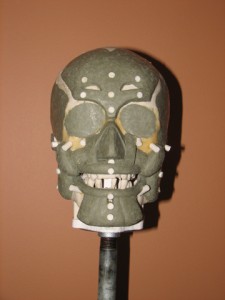
Facial reconstruction of Thomas Lawless 4 - muscles are placed on the skull, Copyright by Permission of Christian Corbet
The facial reconstruction procedure was the initial stage in the identification process and the end result (the sculpture) was used by Dr Andrew Nelson of the University of Western Ontario for computer superimpositions in order to identify the subject. Dr Nelson began his work on this particular identification process in 2007. The condition of the remains meant that Dr Nelson reconstructed the bony part of the midface in epoxy resin and a computer model of the skull was then made. A three dimensional print using bone fragments and photographic superimposition (for the midface) was then created.
This gave Christian Corbet the base to work from for a forensic reconstruction of the face (as shown in the photographs). The team had photos of all the proposed subjects and so a comparison could be made between the sculpture and photos. By eliminating those whose facial characteristics did not match, the shortlist was reduced to two soldiers – one from Cape Breton and the other from Ireland. It was at this stage that that Dr. Nelson suggested isotope analysis – the method by which the Irishman, Thomas Lawless was eventually identified. As Christian Corbet wrote to me, this multidisciplinary collaborative project is said to be a first of its kind in identifying a soldier of the Great War. I think that it is the model for future studies and shows what can be done with available resources, time and skilled personnel.
Mr Corbet’s protégé Benjamin Trickett Mercer told me that the 3-dimensional sculpture of Thomas Lawless took approximately 5 days to complete. It is estimated that approximately 25 – 30 hours were spent on finishing the formal portrait. Help regarding the accoutrements of a Great War soldier were provided by the costume department of the Canadian War Museum. This ensured that the correct regimental badges could be sculpted. They even assisted in the providing the essential but easily overlooked measurements for the size of the soft cap.
Burial – 15 March 2011
Mr Corbet and Benjamin Trickett Mercer attended the burial service on 15 March 2011. Mr Corbet had the honour to place flowers on the grave of Thomas Lawless on behalf of the Province of Newfoundland and Labrador.
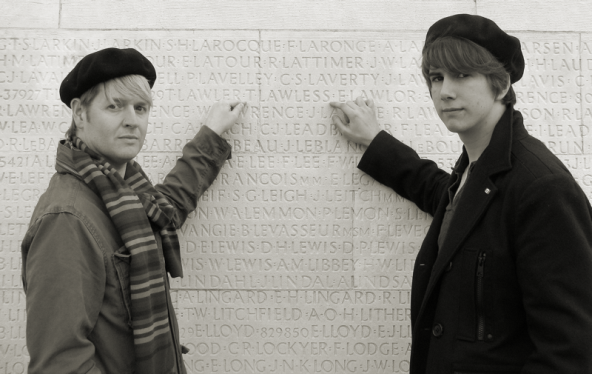
Christian Corbet and his protégé Benjamin Trickett Mercer pointing to the name of Thomas Lawless at the Vimy Memorial. Copyright by Permission of Christian Corbet
On the same note, I received a Press Release earlier from the CPA. It is shown below in italics along with the photograph.
Newfoundland and Labrador Presents Floral Tribute to Fallen WWI Soldier
Avion, France – In an act of respect the province of Newfoundland and Labrador paid homage with a floral bouquet at the burial of Pte. Thomas Lawless on 15th March in Avion, France.
Premier Dunderdale granted permission to Christian Corbet an Academician of the Canadian Portrait Academy to lay flowers of white lilies and red roses upon the grave of Pte. Lawless. Pte. Lawless’ fought at the Battle of Vimy Ridge and his identity was recently released after he went missing in action in June 1917.
This floral tribute was the only one presented from a province or territory from Canada.
Christian Corbet who worked as the Forensic Artist with the Department of National Defence among other institutions in order help identify the remains of the World War I soldier stated “This bouquet of flowers was Newfoundland and Labradors way of saying “Thank You for laying your life down for the freedom we so often take for grated today.” The Irish descendants of Pte. Thomas Lawless were greatly appreciative and grateful for such a kind gesture.”

Christian Corbet presented a floral tribute to fallen WWI soldier on behalf of the Province of Newfoundland and Labrador at La Chaudiere Military Cemetery, France. Photo Credit: Benjamin Trickett Mercer, CPA.
For more information on the burial: http://www.cmp-cpm.forces.gc.ca/dhh-dhp/adh-sdh/news-nouvelle-eng.asp
Please find below some more photos of the burial service, courtesy of Christian Corbet.
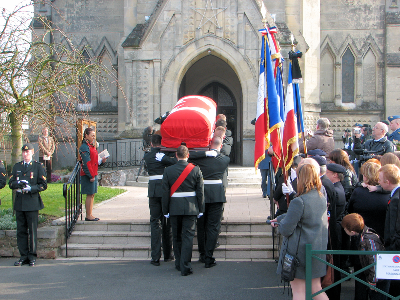
The coffin of Thomas Lawless is carried into the church of Saint-Martin de Vimy. Copyright by Permission of Christian Corbet

Canadian armed forces and standard bearers at the funeral service of Thomas Lawless. Copyright by Permission of Christian Corbet

Thomas Lawless's coffin is carried to his grave at La Chaudiere Military Cemetery, Vimy. Copyright by Permission of Christian Corbet
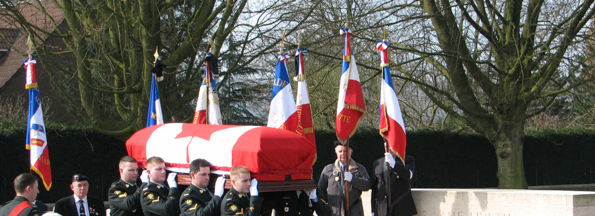
Thomas Lawless's coffin is carried past French standard bearers. Copyright by Permission of Christian Corbet
I would welcome any comments you have on the subject.
Today saw the burial of Private Thomas purchase tramadol generic ultram Lawless, 49th Battalion, Canadian Expeditionary Force almost 94 years after he was killed in action. He was buried with full military honours at La Chaudière Military Cemetery in Vimy with members of his family in attendance.

Burial of Private Thomas Lawless, 49th Battalion, CEF at La Chaudière Military Cemetery, Vimy on 15 March 2011
The remains of Private Lawless and Private Herbert Peterson were found by construction workers near Avion in 2003. They had been killed in August 1917. Subsequent forensic procedures identified Peterson in 2007. The positive identification of Lawless was announced last month – see my blog post: Remains of Canadian Great War soldier finally identified – Private Thomas Lawless, 49th Battalion CEF.
Some pictures of today’s ceremony from the Calgary Sun website can be viewed by clicking on: WWI soldier buried in France.
The pictures on this blog post were taken by a friend who attended today’s burial service. I was unable to make it to Vimy and so offer my thanks to Isabelle Pilarowksi for permission to use her photographs.
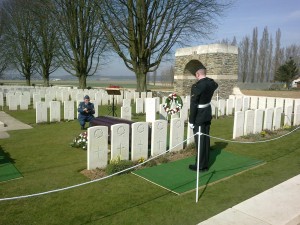
Burial of Private Thomas Lawless, 49th Battalion, CEF at La Chaudière Military Cemetery, Vimy on 15 March 2011
I will be posting some pictures soon from Christian Corbet, the renowned Canadian sculptor of his work on the facial forensic reconstruction of Lawless’s face. Mr Corbet has been kind enough to supply these for my site. Please see this post for the pictures.
The Department of National Defence announced the news of today’s burial here. A full transcript of that announcement can be found below in italics.
PAS-DE-CALAIS, France – Nearly a century after his death, Private Thomas Lawless, a Canadian First World War soldier whose remains were recovered and identified on January 10, 2011, was buried today with full military honours at La Chaudière Military Cemetery, in Vimy, France.
“The courage and dedication of our Canadian First World War heroes will never be forgotten,” said the Honourable Peter MacKay, Minister of National Defence. “After all these years, we finally recognize Private Thomas Lawless with the honour and dignity he so greatly deserves.”
Private Lawless was born on April 11, 1889, in Dublin, Ireland, and enlisted with the Canadian Expeditionary Force (CEF) in Calgary, Alberta. He was a member of the 49th Battalion, CEF, who fought in the Battle of Vimy Ridge.
Veterans Affairs Canada has provided support to the family members of Private Lawless and has also coordinated their participation in the interment ceremony.
“It is very gratifying that we can properly lay to rest a Canadian who made the ultimate sacrifice for our country and our way of life,” said Honourable Jean-Pierre Blackburn, Minister of Veterans Affairs and Minister of State (Agriculture). “We are now able to share Private Lawless’s full story of courage with other Canadians and assure his family that we will remember him.”
In October 2003, two sets of human remains were found at a construction site in the vicinity of Vimy Ridge, France. The first soldier was identified in February 2007, as Private Herbert Peterson of Berry Creek, Alberta. On January 10, 2011, Private Lawless’ remains were identified by the Casualty Identification section of the Directorate of History and Heritage after a combination of anthropological, historical and biological research such as generic testing, osteology, facial reconstruction and military historic records were conclusive.
Commemorative Service to be held at Memorial Wall, Wellington Quarry, Arras at 6.30 am, 9 April 2011
Calling all Western Front visitors!
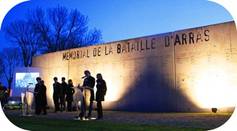 With so much emphasis on the 1 July commemorations on the Somme and the mass pilgrimage that takes place every year, this buy ambien sleeping tablets year please spare a thought for the men who fought in the 1917 Battle of Arras. It was the most savage infantry offensive of the war with the highest daily rate of casualties – over 4,000 men per day. The campaign started with enormous success on Easter Monday, 9 April 1917 with the greatest advance of the war to date but ended in disillusionment and utter exhaustion 39 days later in the fields around Oppy, Roeux, Monchy-le-Preux and Cherisy. Arras is by far my favourite place to visit – there is something about it that I just can’t get enough of and even when driving down to the Somme for a tour, recce or meeting I feel a slight wistfulness as I pass the Vimy Memorial, the grain silos at Roeux, so close to the site of the dreaded Chemical Works and the spire of Monchy church with Monchy British Cemetery in the foreground.
With so much emphasis on the 1 July commemorations on the Somme and the mass pilgrimage that takes place every year, this buy ambien sleeping tablets year please spare a thought for the men who fought in the 1917 Battle of Arras. It was the most savage infantry offensive of the war with the highest daily rate of casualties – over 4,000 men per day. The campaign started with enormous success on Easter Monday, 9 April 1917 with the greatest advance of the war to date but ended in disillusionment and utter exhaustion 39 days later in the fields around Oppy, Roeux, Monchy-le-Preux and Cherisy. Arras is by far my favourite place to visit – there is something about it that I just can’t get enough of and even when driving down to the Somme for a tour, recce or meeting I feel a slight wistfulness as I pass the Vimy Memorial, the grain silos at Roeux, so close to the site of the dreaded Chemical Works and the spire of Monchy church with Monchy British Cemetery in the foreground.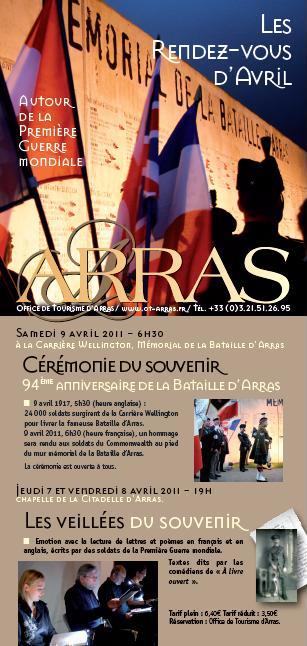
I have just received details of the annual commemorative service to be held at the Wellington Quarry, Arras on Saturday 9 April 2011 at 0630hrs (local time). This service, held on the 94th anniversary of the start of battle is held at the Memorial Wall – if you come into the car park from the Beaurains road then you won’t miss it. The ceremony is open to all.
Sadly, owing to work and family commitments I will not be able to make it this year but have passed my apologies on to Isabelle Pilarowski and her colleagues. I know that the organisers like to use extracts from soldiers who actually took place in the battle and, having given Isabelle a copy of the 1000 page memoir of Percy Clare, 7th East Surrey Regiment, she has promised that she will be using his superb descriptions of battle during the service. Percy’s memoirs were used extensively in the Arras panorama book – from his descriptions of pre-battle training, through the 9 April attack and subsequent days spent between Arras and the fields below Monchy ending with the fateful 3 May attacks – a very black day for the Third Army.
 As a way of thanking the copyright holders we gave them a highly personalised tour of the Arras battlefield (following the 7th East Surreys) when they came over in November 2010 to listen to our lecture in French. More details can be found by reading the blog post here: Arras – battlefield tour & lecture: 12 November 2010
As a way of thanking the copyright holders we gave them a highly personalised tour of the Arras battlefield (following the 7th East Surreys) when they came over in November 2010 to listen to our lecture in French. More details can be found by reading the blog post here: Arras – battlefield tour & lecture: 12 November 2010
A two-sided pdf file with more details on April’s events is available on request – please contact me here and I will email you a copy.
These events include guided walks & tours (French speaking only) in Neuville-St-Vaast, Roeux and Arras itself and seem very good value at just €3.00 per person.
I will certainly have the men of the Third Army in my memories on the morning of 9 April and would urge anyone over on a battlefield tour at that time to attend and pay their respects.
Remains of Canadian Great War soldier finally identified – Private Thomas Lawless, 49th Battalion CEF
I was delighted to read that a Canadian casualty of the Great War whose remains were found by construction workers near Avion in 2003 have now been identified using DNA. The man, a 28-year-old Irish immigrant 183425 Private Thomas Lawless, 49th Battalion (Alberta Regiment), Canadian Expeditionary Force was killed in a raid on the German lines on 9 June 1917.
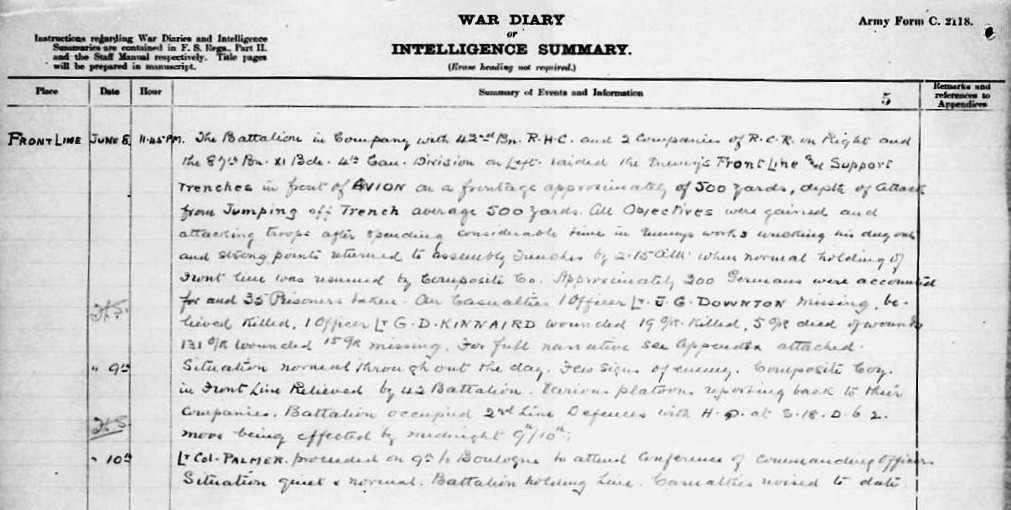
49th Bn War Diary extract 8th - 9th June 1917. Note the large losses - including 131 Other Ranks wounded and 15 O.R. missing. CLICK TO ENLARGE
Press reports indicate that his remains, along with those of 808723 Private Herbert Peterson of the same battalion, were discovered during a road-building project. Private Peterson’s remains were positively identified in 2007 and were buried with full military honours at La Chaudière Military Cemetery in Vimy in the same year.
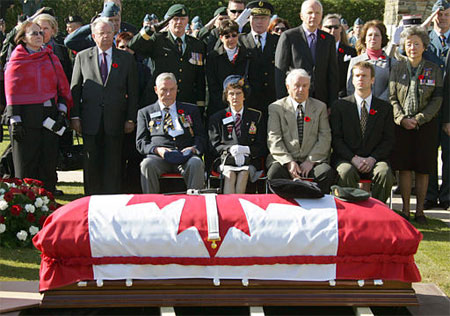
The burial of Private Herbert Peterson in 2007. He was killed on 9 June 1917 near Avion and his remains were found by construction workers in 2003. Image by Michael Springler taken from www.reallygoodfriend.com
It took six years of research and testing before forensic scientists and DNA specialists could positively identify Thomas Lawless. The remains of both men had been returned to Canada because metal insignia identified their battalion and nationality.
The story has been covered in the Canadian Press. Links below to the Edmonton Journal and The Vancouver Sun.
The Vancouver Sun – Researchers ID fallen soldier from First World War
Thomas Lawless’s details are recorded in the CWGC register HERE. Interestingly he is reported as being buried in La Chaudière Military Cemetery in Vimy, despite the service not taking place until 15 March 2011. The service will take place with members of his Irish family in attendance.
As a ‘missing’ Canadian soldier, Thomas Lawless is still commemorated on the Vimy Memorial. The memorial is inscribed with the names of over 11,000 Canadian soldiers who were posted as ‘missing, presumed dead’ in France. The Canadian Virtual War Memorial confirms that Thomas Lawless is on the Vimy Memorial: PRIVATE THOMAS LAWLESS
Below is the official notification of the positive identification of Private Lawless: Historic Casualty Identification
BG–11.002 – February 24, 2011
The Government of Canada, the Department of National Defence and the Canadian Forces are dedicated to honouring those who have made the ultimate sacrifice by ensuring that, when possible, they will be identified and buried in a known grave.
Nearly 28 000 members of Canada’s Army, Air Force, and Navy who died in the First and Second World Wars and the Korean War have no known or maintainable grave. The majority of these service personnel – approximately 19 500 – went missing in France and Belgium during the First World War. Every year, some of the formerly missing are discovered, and the Department of National Defence is responsible for using historical and scientific methods to determine their identity.
Identification is the result of a collection of historical research and biological tests which eventually determine the most likely serviceman.
The first step in identification is to search records, such as military personnel records, burial registrar records, war diaries and maps, and regimental histories to create an historical profile of the unknown person. Purely historical identifications are rare, however, and DND usually seeks biological evidence to support other documents.
Biological anthropologists study the remains to determine the number of persons, their ages and heights, their dental health, their overall health and if possible, clues as to how they may have died. The resulting profile can further reduce the final list of candidates, and genetic testing of the remaining candidates can lead to an identification or reduce the candidate pool further.
Genetic testing of war remains requires that DNA be extracted from bone or teeth and then compared with genetic material donated by the descendents of the candidates.
Unfortunately, the use of DNA, while a method which has made identification more likely, can be limited by the availability of donors and the difficulty of extracting viable DNA from older remains. More recently, National Defence has used stable isotope technology to help differentiate the origins of candidates. By using the regional properties of certain elements to track the mobility of an individual, stable isotope technology can detect the locations in which an individual has been raised (to the age of approximately 21) and the locations in which an individual lived in the final ten to fifteen years of their lives. Such testing allows DND to exclude candidates based on where they were raised or where they lived prior to enlistment.
No doubt new technologies and increased access to historical documents will further enhance the precision and ability to identify Canada’s unknown soldiers, sailors and airmen and airwomen.
I think this is a great job by the Canadians and shows what can be done with some dedication and by providing the necessary budget. My congratulations go the Canadian government but also to the unsung heroes – the many professionals whose collaborative efforts in freely offering their time made this historical identification possible. Now, owing to their efforts, Private Lawless can finally rest in peace in a named grave. It would be wonderful if a similar effort was found in providing positive ID to the bodies of fifteen men from the York and Lancaster Regiment who were found in the French village of Beaucamps-Ligny in November 2009.
It has been reported in the Australian press (Sydney Morning Herald) that the body of an Australian soldier has been found on the Somme battlefield. The piece, entitled ‘Somme gives up the body of another Anzac’ dated 17 January tells of a the remains of a body being disturbed during digging for a drainage ditch near the infamous site of Mouquet Farm (also known as Moo Cow or Mucky Farm).
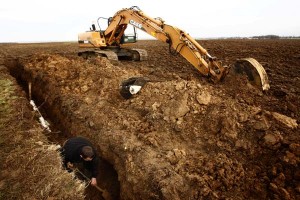
The site near Mouquet Farm where the Australian soldier's remains were found. Published online at http://www.smh.com.au/. Copyright Mike Bowers
The remains were excavated by local café owner Dominique Zanardi who was on site with the Mayor of Pozières. The report mentions that “there was no identity disc on the body, the soldier’s pistol holster is stamped “AUSTRALIA” and “WA””. I know I am not alone in advocating the involvement of qualified archaeologists using a professional approach. The issue of finding bodies on the battlefield has been going on for 90+ years but, following the precedent set by the dig at Fromelles, it is a very backward step to allow amateur excavation of these sites, however well intentioned the persons involved may be. The shocking pictures from the retrieval of fifteen British soldiers at Beauamps-Ligny are clear evidence of the need to employ professionals.
A follow-up piece entitled ‘Army moves to claim lost Digger‘ was published today which elaborates further on the next steps.

